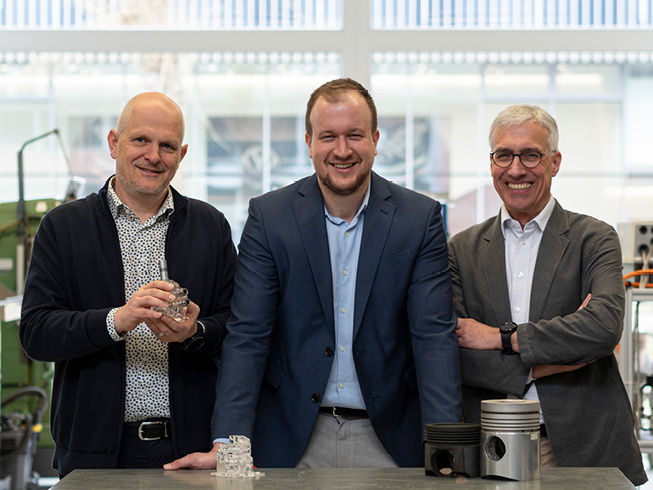Electricity from waste heat
Empa/ETH spin-off aims to increase energy efficiency
Advertisement
Industrial waste heat is an untapped goldmine: It is produced in large quantities, but is hardly used efficiently. A new type of machine developed by Empa scientists and their partners based on an innovative engine technology could change this – also with the help of an Empa Entrepreneur Fellowship, which was recently awarded to Empa researcher and neo-entrepreneur Andyn Omanovic.

Inventive spirit in the team: from left, Patrik Soltic, Andyn Omanovic and Wolfgang Schneider.
Empa
Good ideas sometimes take surprising turns. For years, experts at Empa had been working on an innovative valve control system for combustion engines with electro-hydraulically actuated valves, which make it possible to make the gas change much more flexible than with conventional camshaft technology. In a gasoline engine, fuel consumption could be reduced by around 20 percent in typical operation mode for passenger cars. This approach is now being developed further for fuel-flexible engines in cargo vehicles together with a truck manufacturer.
But now this technology could also enable progress in another area. Empa has awarded its former doctoral student Andyn Omanovic an Entrepreneur Fellowship to bring a new type of piston machine with this control system to market. Commercialization will be handled by etavalve GmbH, a spin-off of Empa and ETH Zurich, which was co-founded by hydraulics expert Wolfgang Schneider, who was involved in the development of the technology.
The idea is to use waste heat from processes in the metal or cement industry and other areas more efficiently with the help of the aforementioned piston machine than with current methods that work with turbines. As the cylinder and piston form a closed space, explains Omanovic, the compression and expansion of the process take place in an almost ideal way; this enables an extremely high energy yield: The waste heat is converted into mechanical power via the pistons, which is ultimately used to generate electricity. However, this process can only be implemented at all thanks to the innovative flexible control of the valves.
"Turbines are particularly effective at high temperatures and for power requirements of several hundred megawatts," explains the Empa researcher, "but our piston machine is better suited for temperature ranges of around 500 to 900 degrees, where the waste heat is generated irregularly, and up to the power range of several megawatts." The potential is high: In 2016, the amount of industrial waste heat above 300 degrees in Germany was estimated at around 10 terawatt hours per year. By comparison, according to the Association of Swiss Electricity Companies (VSE), last year around 57 terawatt hours of electricity were consumed in Switzerland.
Using climate-friendly biochar plants
The use of waste heat from pyrolysis plants, which convert biomass into biochar in order to bind carbon permanently, is also promising – a process that Empa researchers are also working on. The by-product of this process is so-called lean gas, which contains methane and gaseous pollutants and must be incinerated, as required by law. "This is often done with a gas flare without any utilization of the energy," explains Omanovic, "we use this heat to generate electricity with our piston machine."
Before the step into practice
By the beginning of 2025, a pilot machine is to be built for the energy supplier IWB in Basel, which is pushing the development of biochar plants in Switzerland – designed and built specifically for the properties of the waste heat generated during pyrolysis.
Around a year later, according to the developers at etavalve, a small series of piston machines should be delivered to a company that specializes in plants for the combustion of lean gases from landfills or biogas processing. Talks are already underway.
The experts at etavalve are therefore confident that their technology could reach the market in the foreseeable future – despite challenges in technical details such as temperature-resistant materials for the machine and the control strategy for the thermodynamic process, which still need to be mastered. But cost-benefit calculations are also highly promising. "The manufacturing and operation of our very first pilot machine almost covers its costs," says Omanovic, "which is by no means a matter of course for an innovative technology in complex mechanical engineering."
Other news from the department business & finance
Most read news
More news from our other portals
Something is happening in the chemical industry ...
This is what true pioneering spirit looks like: Plenty of innovative start-ups are bringing fresh ideas, lifeblood and entrepreneurial spirit to change tomorrow's world for the better. Immerse yourself in the world of these young companies and take the opportunity to get in touch with the founders.



























































